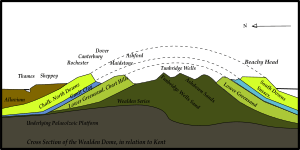Vale of Kent facts for kids
The Vale of Kent is a wide, flat valley in Kent, England. It sits between two higher areas: the Greensand Ridge and the High Weald. Many rivers flow through this area, like the Beult, Eden, Medway, Stour, and River Teise.
Some important towns in the Vale of Kent are Ashford and Tonbridge.
Understanding the Geology of the Vale of Kent
The Weald area, which includes the Vale of Kent, was once a huge dome of rock layers. Geologists call this shape an anticline. Over millions of years, wind and rain have worn away the top of this dome. This process, called erosion, has exposed different layers of rock.
How the Weald Was Formed
The rocks in this area were formed during the Lower Cretaceous period. Imagine a giant cake with many layers. The oldest layers are at the very bottom. In the Weald, the oldest rocks are similar to the Purbeck Beds from the Upper Jurassic period.
Above these, you find the Wealden Group of rocks. These layers switch between sandstone (a hard, sandy rock) and clay (a soft, sticky rock). Examples include the Ashdown Sand, Wadhurst Clay, and Tunbridge Wells Sand. Above the Wealden Group are layers like the Lower Greensand and the Gault Clay.
High Weald and Low Weald Explained
The central part of the Weald dome has very hard sandstones. These tough rocks have resisted erosion better, forming higher hills. This area is known as the High Weald.
The areas around the High Weald have softer sandstones and clays. These rocks wear away more easily, creating a gentler, rolling landscape. This flatter area is called the Low Weald. The Vale of Kent is a part of this Low Weald region.
The same geological structure, the Weald-Artois Anticline, actually stretches even further. It goes about 65 kilometers (40 miles) southeast, right under the Straits of Dover. It even reaches into an area of France called the Boulonnais.



